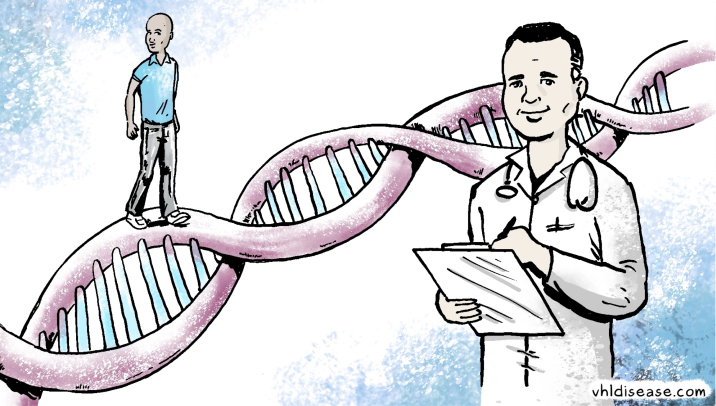

Follow the patient journey, beginning with the identification of specific manifestations that may raise suspicion of VHL disease.
A rare, genetic, and cyclical condition1–3
Key insights into cyst and tumor manifestations
commonly
associated with VHL disease a
- Overview
- Family History
- Brain and Spinal Cord
- Retina
- Endolymphatic Sac
- Kidneys
- Pancreas
- Adrenal Glands
- Overview
- Endolymphatic Sac
- Family History
- Kidneys
- Brain/Spinal Cord
- Pancreas
- Retina
- Adrenal Glands
VHL disease is a persistent condition that can cause recurrent cyst and tumor growth over the course of a patient’s lifetime.1,3,4
Although VHL disease is progressive, early diagnosis, close monitoring, and prompt intervention can help patients manage disease manifestations and reduce morbidity and mortality.4–6

VHL disease is a largely heritable
condition, with
Therefore, a family history of VHL disease is a strong indicator of the condition. While the majority of cases have a family history, about 20% of patients diagnosed with VHL disease arise from de novo mutations.4

 Brain and Spinal Cord
Brain and Spinal Cord
Prevalence
- Central nervous system (CNS) hemangioblastomas—which occur in the cerebellum, brainstem, spinal cord, cauda equina, or supratentorial region—are the most common tumors in patients with VHL disease, affecting up to 80% of patients with VHL disease.4
Presentation
- The average age of presentation is 33 years.4
Possible symptoms
- Depending on where they appear, hemangioblastomas may cause
headaches, vomiting, ataxia and gait
disturbances, pain, sensory and motor loss,
or severe defects including vision loss.3,4,7

 Retina
Retina
Prevalence
- Retinal hemangioblastomas occur in as many
as 60% of patients with VHL disease.4
Presentation
- Often the first manifestation of VHL disease.4
Possible symptoms
- Severe visual deficits and blindness.3,4,7


 Endolymphatic Sac
Endolymphatic Sac
Prevalence
- Endolymphatic sac tumors occur in approximately 15% of people with VHL disease.8
Presentation
- Endolymphatic sac tumors present at an
average age of 31 years.4 - Often misdiagnosed as Meniere’s disease.8
Possible symptoms
- Vestibular symptoms, partial/complete
hearing loss, tinnitus, ear fullness,
and/or facial paresis.3,4,9
Prognosis
- While these tumors are benign and do
not metastasize, they may be locally
aggressive.4


 Kidneys
Kidneys
Prevalence
- As many as 70% of people with VHL disease develop clear cell renal cell carcinoma (RCC)
by age 60.10 - Multiple bilateral renal cysts are found on screening in 50% to 70% of patients with
VHL disease.4
Presentation
- RCC or cysts present at an average age of
39 years.4 - VHL disease–associated RCC should be suspected if the patient was diagnosed at age ≤46 years, has bilateral or multifocal tumors, or has 1 or more first- or second-degree relatives with RCC and clear cell histology.4,7,11,12
Prognosis
- RCC is a leading cause of death in patients who experience VHL disease–associated RCC4


 Pancreas
Pancreas
Prevalence
- Pancreatic tumors or cysts occur in
approximately 35%–70% of patients with
VHL disease.4
Presentation
- Macroscopically, pancreatic neuroendocrine tumors (pNETs) are well distinguished,
variegated red-brown to yellow-tan masses.13 - Lesions are usually hypervascular, have a characteristic appearance on cross-sectional imaging,
and may behave in a malignant
manner and present with metastases.13 - Compression of nearby structures by pancreatic cysts or pNETs can cause symptoms.4
Prognosis
- Neuroendocrine tumors can become
malignant and metastatic in 8% of these
patients, but rarely contribute to morbidity
and mortality.4


 Adrenal Glands
Adrenal Glands
Prevalence
- Pheochromocytomas occur in up to
20% of patients with VHL disease.4
Presentation
- These tumors present at an average age of
30 years.4
Possible symptoms
- Paroxysmal or sustained hypertension, palpitations, tachycardia, headaches,
sweating, pallor, and nausea.4,10
Prognosis
- Pheochromocytomas are rarely malignant.4


aThese are common manifestations of VHL disease, and this is not an exhaustive list. Patients with VHL disease may present with additional manifestations. Manifestation will vary from patient to patient.
Learn more about key clinical characteristics of VHL disease with Dr. Brian M. Shuch.


VHL = von Hippel-Lindau.




